Role of Long Non-Coding RNA X-Inactive-Specific Transcript (XIST) in Neuroinflammation and Myelination: Insights from Cerebral Organoids and Implications for Multiple Sclerosis
Abstract
1. Introduction
2. Results
2.1. Myelinated and LPS-Induced Human Cerebral Organoids Were Generated from H9 Cells Transfected with XIST-siRNA or Scramble
2.2. Silencing of XIST Increased the Abundance of Neural Stem Cells, Excitatory Neurons, Mature Oligodendrocytes, and Microglia
2.3. Silencing of XIST Alters the Expression Levels of Myelination- and Inflammation-Related Genes and the Response to DMTs
2.4. Silencing of XIST Activates Microglia Without Altering MBP Protein Expression
2.5. Silencing of XIST Affects the Level of Alpha-Synuclein Secretion
2.6. Silencing of XIST Caused Differential Expression of Genes Related to Neural Development and Morphogenesis in Human Cerebral Organoids
2.7. Silencing of XIST Did Not Significantly Affect Secretome Profiling Related to Immune Response and Myelination
3. Discussion
4. Materials and Methods
4.1. Feeder-Dependent Culture of H9 hESCs
4.2. Silencing of XIST by XIST-siRNA
4.3. 3D Cerebral Organoid Generation from hESCs
4.4. Treatment of Human Cerebral Organoids with Disease-Modifying Agents
4.5. Determination of Gene Expression via qRT-PCR
4.6. Immunofluorescence (IF) Staining of Organoid Tissues
4.7. Determination of Alpha-Synuclein Levels via ELISA
4.8. Transcriptome Analysis
4.9. Secretome Analysis
4.10. Bioinformatic Analysis
5. Conclusions
Supplementary Materials
Author Contributions
Funding
Institutional Review Board Statement
Informed Consent Statement
Data Availability Statement
Acknowledgments
Conflicts of Interest
Abbreviations
- The following abbreviations are used in this manuscript:
| ACN | Acetonitrile |
| AD | Alzheimer’s disease |
| APP | ß-amyloid precursor protein-cleaving enzyme-1 |
| BDNF | Brain-derived neurotropic factor |
| bFGF | Basic fibroblast growth factor |
| BSA | Bovine serum albumin |
| CD40L | Cluster of differentiation 40 |
| ceRNA | Competitive endogenous RNA |
| CNS | Central nervous system |
| CXCL14 | Chemokine (C-X-C motif) ligand 14 |
| DAPI | 4′,6-Diamidino-2-phenylindol |
| DAVID | The Database for Annotation, Visualization, and Integrated Discovery |
| DEGs | Differentially expressed genes |
| DMEM | Dulbecco’s modified Eagle’s medium |
| DMF | Dimethyl fumarate |
| DMTs | Disease-modifying therapies |
| EBs | Embryoid bodies |
| EDTA | Ethylenediaminetetraacetic acid |
| ELISA | Enzyme-linked immunosorbent assay |
| FA | Formic acid |
| FDA | Food and Drug Administration |
| FDR | False discovery rate |
| FOXP3 | Forkhead box P3 |
| FTY720 | Fingolimod (Gilenya) |
| GFAP | Glial fibrillary acidic protein |
| GO | Gene ontology |
| GSEA | Gene set enrichment analysis |
| hESCs | Human embryonic stem cells |
| HNRNPA1 | Heterogeneous nuclear ribonucleoprotein A |
| IBA1 | Ionized calcium-binding adapter molecule 1 |
| IF | Immunofluorescence |
| IGF1 | Insulin growth factor |
| IL-10 | Interleukin 10 |
| IL-1α | Interleukin-1 alpha |
| IL-1β | Interleukin-1 beta |
| IL-6 | Interleukin 6 |
| iMEF | Mitotically inactive murine embryonic fibroblast |
| iNOS | Inducible nitric oxide synthase |
| IRAK-1 | Interleukin-1 receptor-associated kinase 1 |
| J774A.1 | Mouse macrophage cells |
| KDM6A | Histone lysine demethylase 6A |
| KEGG | Kyoto Encyclopaedia of Genes and Genomes |
| KOSR | Knockout serum replacement |
| LC-MS/MS | Liquid chromatography–mass spectrometry |
| LPS | Lipopolysaccharide |
| MAP1B | Microtubule-associated protein 1B |
| MBP | Myelin basic protein |
| MEM | Minimal essential medium |
| MS | Multiple Sclerosis |
| MSN | Moesin |
| NANOG | Homeobox protein NANOG |
| NEAA | Nonessential amino acids |
| NT3 | Neurotropin 3 |
| OCT | Optimum cutting temperature |
| PARP1 | Poly (ADP-ribose)-polymerase-1 |
| PBS | Phosphate-buffered saline |
| PDGF | Platelet-derived growth factor |
| PLP1 | Proteolipid protein 1 |
| qRT-PCR | Quantitative reverse transcription polymerase chain reaction |
| ROCK | Rho-associated protein kinase |
| S1PRs | Sphingosine-1-phosphate receptors |
| SATB2 | Special AT-rich sequence-binding protein 2 |
| siRNA | Small inhibitory RNA |
| SLE | Systemic lupus erythematosus |
| SOX2 | Sex-determining region Y-box 2 |
| T3 | 3,3′,5-triiodothyronine |
| TAU | Tubulin associated unit |
| TLR7 | Toll-like receptor 7 |
| TMM | Trimmed mean of M |
| TNF | Tumor necrosis factor |
| TUBITAK | The Scientific and Technological Research Council of Türkiye |
| TUSEB | Health Institutes of Türkiye |
| UHPLC | Ultra-high-performance liquid chromatography |
| Vim | Vimentin |
| XCI | X chromosome inactivation |
| XIST | X-inactive specific transcript |
References
- Brown, C.J.; Hendrich, B.D.; Rupert, J.L.; Lafreniere, R.G.; Xing, Y.; Lawrence, J.; Willard, H.F. The human XIST gene: Analysis of a 17 kb inactive X-specific RNA that contains conserved repeats and is highly localized within the nucleus. Cell 1992, 71, 527–542. [Google Scholar] [CrossRef] [PubMed]
- da Rocha, S.T.; Heard, E. Novel players in X inactivation: Insights into Xist-mediated gene silencing and chromosome conformation. Nat. Struct. Mol. Biol. 2017, 24, 197–204. [Google Scholar] [CrossRef]
- Li, J.; Ming, Z.; Yang, L.; Wang, T.; Liu, G.; Ma, Q. Long noncoding RNA XIST: Mechanisms for X chromosome inactivation, roles in sex-biased diseases, and therapeutic opportunities. Genes Dis. 2022, 9, 1478–1492. [Google Scholar] [CrossRef] [PubMed]
- Wang, W.; Min, L.; Qiu, X.; Wu, X.; Liu, C.; Ma, J.; Zhang, D.; Zhu, L. Biological Function of Long Non-coding RNA (LncRNA) Xist. Front. Cell Dev. Biol. 2021, 9, 645647. [Google Scholar] [CrossRef]
- Siniscalchi, C.; Di Palo, A.; Russo, A.; Potenza, N. The lncRNAs at X Chromosome Inactivation Center: Not Just a Matter of Sex Dosage Compensation. Int. J. Mol. Sci. 2022, 23, 611. [Google Scholar] [CrossRef] [PubMed]
- He, X.; Yang, L.; Huang, R.; Lin, L.; Shen, Y.; Cheng, L.; Jin, L.; Wang, S.; Zhu, R. Activation of CB2R with AM1241 ameliorates neurodegeneration via the Xist/miR-133b-3p/Pitx3 axis. J. Cell Physiol. 2020, 235, 6032–6042. [Google Scholar] [CrossRef]
- Yue, D.; Guanqun, G.; Jingxin, L.; Sen, S.; Shuang, L.; Yan, S.; Minxue, Z.; Ping, Y.; Chong, L.; Zhuobo, Z.; et al. Silencing of long noncoding RNA XIST attenuated Alzheimer’s disease-related BACE1 alteration through miR-124. Cell Biol. Int. 2020, 44, 630–636. [Google Scholar] [CrossRef]
- Zhou, Q.; Zhang, M.M.; Liu, M.; Tan, Z.G.; Qin, Q.L.; Jiang, Y.G. LncRNA XIST sponges miR-199a-3p to modulate the Sp1/LRRK2 signal pathway to accelerate Parkinson’s disease progression. Aging 2021, 13, 4115–4137. [Google Scholar] [CrossRef]
- Zhao, Q.; Lu, F.; Su, Q.; Liu, Z.; Xia, X.; Yan, Z.; Zhou, F.; Qin, R. Knockdown of long noncoding RNA XIST mitigates the apoptosis and inflammatory injury of microglia cells after spinal cord injury through miR-27a/Smurf1 axis. Neurosci. Lett. 2020, 715, 134649. [Google Scholar] [CrossRef]
- Wang, Y.; Jiang, F.; Chen, F.; Zhang, D.; Wang, J. LncRNA XIST Engages in Psoriasis via Sponging miR-338-5p to Regulate Keratinocyte Proliferation and Inflammation. Skin. Pharmacol. Physiol. 2022, 35, 196–205. [Google Scholar] [CrossRef]
- Cohen, J.; Mathew, A.; Dourvetakis, K.D.; Sanchez-Guerrero, E.; Pangeni, R.P.; Gurusamy, N.; Aenlle, K.K.; Ravindran, G.; Twahir, A.; Isler, D.; et al. Recent Research Trends in Neuroinflammatory and Neurodegenerative Disorders. Cells 2024, 13, 511. [Google Scholar] [CrossRef] [PubMed]
- D’Anca, M.; Buccellato, F.R.; Tartaglia, G.M.; Del Fabbro, M.; Muti, P.; Scarpini, E.; Galimberti, D.; Ghezzi, L. Why Is Multiple Sclerosis More Frequent in Women? Role of the Immune System and of Oral and Gut Microbiota. Appl. Sci. 2023, 13, 5881. [Google Scholar] [CrossRef]
- Nytrova, P.; Dolezal, O. Sex bias in multiple sclerosis and neuromyelitis optica spectrum disorders: How it influences clinical course, MRI parameters and prognosis. Front. Immunol. 2022, 13, 933415. [Google Scholar] [CrossRef] [PubMed]
- Klein, S.L.; Flanagan, K.L. Sex differences in immune responses. Nat. Rev. Immunol. 2016, 16, 626–638. [Google Scholar] [CrossRef]
- Krueger, K.; Lamenza, F.; Gu, H.; El-Hodiri, H.; Wester, J.; Oberdick, J.; Fischer, A.J.; Oghumu, S. Sex differences in susceptibility to substance use disorder: Role for X chromosome inactivation and escape? Mol. Cell Neurosci. 2023, 125, 103859. [Google Scholar] [CrossRef]
- Mousavi, M.J.; Mahmoudi, M.; Ghotloo, S. Escape from X chromosome inactivation and female bias of autoimmune diseases. Mol. Med. 2020, 26, 127. [Google Scholar] [CrossRef]
- Ngwa, C.; Misrani, A.; Manyam, K.V.; Xu, Y.; Qi, S.; Sharmeen, R.; McCullough, L.; Liu, F. Escape of Kdm6a from X chromosome is detrimental to ischemic brains via IRF5 signaling. Res. Sq. 2024, preprint. [Google Scholar] [CrossRef]
- Cipriano, G.L.; Schepici, G.; Mazzon, E.; Anchesi, I. Multiple Sclerosis: Roles of miRNA, lcnRNA, and circRNA and Their Implications in Cellular Pathways. Int. J. Mol. Sci. 2024, 25, 2255. [Google Scholar] [CrossRef]
- Jalaiei, A.; Asadi, M.R.; Sabaie, H.; Dehghani, H.; Gharesouran, J.; Hussen, B.M.; Taheri, M.; Ghafouri-Fard, S.; Rezazadeh, M. Long Non-Coding RNAs, Novel Offenders or Guardians in Multiple Sclerosis: A Scoping Review. Front. Immunol. 2021, 12, 774002. [Google Scholar] [CrossRef]
- Wang, X.; Wang, C.; Geng, C.; Zhao, K. LncRNA XIST knockdown attenuates Aβ(25-35)-induced toxicity, oxidative stress, and apoptosis in primary cultured rat hippocampal neurons by targeting miR-132. Int. J. Clin. Exp. Pathol. 2018, 11, 3915–3924. [Google Scholar]
- Yan, X.W.; Liu, H.J.; Hong, Y.X.; Meng, T.; Du, J.; Chang, C. lncRNA XIST induces Aβ accumulation and neuroinflammation by the epigenetic repression of NEP in Alzheimer’s disease. J. Neurogenet. 2022, 36, 11–20. [Google Scholar] [CrossRef]
- Andrade, F. Opinion: How does XIST promote sex bias in autoimmune diseases? Front. Immunol. 2024, 15, 1399408. [Google Scholar] [CrossRef] [PubMed]
- Yang, J.; Gong, Z.; Dong, J.; Bi, H.; Wang, B.; Du, K.; Zhang, C.; Chen, L. lncRNA XIST inhibition promotes M2 polarization of microglial and aggravates the spinal cord injury via regulating miR-124-3p/IRF1 axis. Heliyon 2023, 9, e17852. [Google Scholar] [CrossRef] [PubMed]
- Zeng, M.; Zhang, T.; Lin, Y.; Lin, Y.; Wu, Z. The Common LncRNAs of Neuroinflammation-Related Diseases. Mol. Pharmacol. 2023, 103, 113–131. [Google Scholar] [CrossRef] [PubMed]
- Ding, Y.; Li, T.; Yan, X.; Cui, M.; Wang, C.; Wang, S.; Zhang, F.; Zhang, R. Identification of hub lncRNA ceRNAs in multiple sclerosis based on ceRNA mechanisms. Mol. Genet. Genom. 2021, 296, 423–435. [Google Scholar] [CrossRef]
- Liu, Z.; Liao, Q.; Wen, H.; Zhang, Y. Disease modifying therapies in relapsing-remitting multiple sclerosis: A systematic review and network meta-analysis. Autoimmun. Rev. 2021, 20, 102826. [Google Scholar] [CrossRef]
- Ferret-Sena, V.; Capela, C.; Macedo, A.; Salgado, A.V.; Derudas, B.; Staels, B.; Sena, A. Fingolimod treatment modulates PPARgamma and CD36 gene expression in women with multiple sclerosis. Front. Mol. Neurosci. 2022, 15, 1077381. [Google Scholar] [CrossRef]
- Roy, R.; Alotaibi, A.A.; Freedman, M.S. Sphingosine 1-Phosphate Receptor Modulators for Multiple Sclerosis. CNS Drugs 2021, 35, 385–402. [Google Scholar] [CrossRef]
- Brennan, M.S.; Patel, H.; Allaire, N.; Thai, A.; Cullen, P.; Ryan, S.; Lukashev, M.; Bista, P.; Huang, R.; Rhodes, K.J.; et al. Pharmacodynamics of Dimethyl Fumarate Are Tissue Specific and Involve NRF2-Dependent and -Independent Mechanisms. Antioxid. Redox Signal 2016, 24, 1058–1071. [Google Scholar] [CrossRef]
- Diebold, M.; Galli, E.; Kopf, A.; Sanderson, N.S.R.; Callegari, I.; Benkert, P.; Gonzalo Nunez, N.; Ingelfinger, F.; Herms, S.; Cichon, S.; et al. High-dimensional immune profiling identifies a biomarker to monitor dimethyl fumarate response in multiple sclerosis. Proc. Natl. Acad. Sci. USA 2022, 119, e2205042119. [Google Scholar] [CrossRef]
- Gross, C.C.; Schulte-Mecklenbeck, A.; Klinsing, S.; Posevitz-Fejfar, A.; Wiendl, H.; Klotz, L. Dimethyl fumarate treatment alters circulating T helper cell subsets in multiple sclerosis. Neurol. Neuroimmunol. Neuroinflamm. 2016, 3, e183. [Google Scholar] [CrossRef] [PubMed]
- Hojjati, S.; Ernerudh, J.; Vrethem, M.; Mellergard, J.; Raffetseder, J. Dimethyl fumarate treatment in relapsing remitting MS changes the inflammatory CSF protein profile by a prominent decrease in T-helper 1 immunity. Mult. Scler. Relat. Disord. 2023, 80, 105126. [Google Scholar] [CrossRef]
- Wu, Q.; Wang, Q.; Mao, G.; Dowling, C.A.; Lundy, S.K.; Mao-Draayer, Y. Dimethyl Fumarate Selectively Reduces Memory T Cells and Shifts the Balance between Th1/Th17 and Th2 in Multiple Sclerosis Patients. J. Immunol. 2017, 198, 3069–3080. [Google Scholar] [CrossRef] [PubMed]
- Lancaster, M.A.; Knoblich, J.A. Generation of cerebral organoids from human pluripotent stem cells. Nat. Protoc. 2014, 9, 2329–2340. [Google Scholar] [CrossRef] [PubMed]
- Acar, B.; Aktas-Pepe, N.; Sen, A. Optimization of myelination on human cerebral organoids for studying multiple sclerosis (MS). EuroBiotech J. 2021, 5, 58. [Google Scholar] [CrossRef]
- Lancaster, M.A.; Renner, M.; Martin, C.A.; Wenzel, D.; Bicknell, L.S.; Hurles, M.E.; Homfray, T.; Penninger, J.M.; Jackson, A.P.; Knoblich, J.A. Cerebral organoids model human brain development and microcephaly. Nature 2013, 501, 373–379. [Google Scholar] [CrossRef]
- Pagin, M.; Pernebrink, M.; Giubbolini, S.; Barone, C.; Sambruni, G.; Zhu, Y.; Chiara, M.; Ottolenghi, S.; Pavesi, G.; Wei, C.L.; et al. Sox2 controls neural stem cell self-renewal through a Fos-centered gene regulatory network. Stem Cells 2021, 39, 1107–1119. [Google Scholar] [CrossRef] [PubMed]
- Syrett, C.M.; Paneru, B.; Sandoval-Heglund, D.; Wang, J.; Banerjee, S.; Sindhava, V.; Behrens, E.M.; Atchison, M.; Anguera, M.C. Altered X-chromosome inactivation in T cells may promote sex-biased autoimmune diseases. JCI Insight 2019, 4, e126751. [Google Scholar] [CrossRef]
- Boziki, M.; Theotokis, P.; Kesidou, E.; Karafoulidou, E.; Konstantinou, C.; Michailidou, I.; Bahar, Y.; Altintas, A.; Grigoriadis, N. Sex, aging and immunity in multiple sclerosis and experimental autoimmune encephalomyelitis: An intriguing interaction. Front. Neurol. 2022, 13, 1104552. [Google Scholar] [CrossRef]
- Kingwell, E.; Marriott, J.J.; Jetté, N.; Pringsheim, T.; Makhani, N.; Morrow, S.A.; Fisk, J.D.; Evans, C.; Béland, S.G.; Kulaga, S.; et al. Incidence and prevalence of multiple sclerosis in Europe: A systematic review. BMC Neurol. 2013, 13, 128. [Google Scholar] [CrossRef]
- Angeloni, B.; Bigi, R.; Bellucci, G.; Mechelli, R.; Ballerini, C.; Romano, C.; Morena, E.; Pellicciari, G.; Renie, R.; Rinaldi, V.; et al. A Case of Double Standard: Sex Differences in Multiple Sclerosis Risk Factors. Int. J. Mol. Sci. 2021, 22, 3696. [Google Scholar] [CrossRef]
- Sun, Z.; Fan, J.; Wang, Y. X-Chromosome Inactivation and Related Diseases. Genet. Res. 2022, 2022, 1391807. [Google Scholar] [CrossRef]
- Gupta, K.; Czerminski, J.T.; Lawrence, J.B. Trisomy silencing by XIST: Translational prospects and challenges. Hum. Genet. 2024, 143, 843–855. [Google Scholar] [CrossRef] [PubMed]
- Jacobson, E.C.; Pandya-Jones, A.; Plath, K. A lifelong duty: How Xist maintains the inactive X chromosome. Curr. Opin. Genet. Dev. 2022, 75, 101927. [Google Scholar] [CrossRef]
- Modarresi, F.; Faghihi, M.A.; Patel, N.S.; Sahagan, B.G.; Wahlestedt, C.; Lopez-Toledano, M.A. Knockdown of BACE1-AS Nonprotein-Coding Transcript Modulates Beta-Amyloid-Related Hippocampal Neurogenesis. Int. J. Alzheimer’s Dis. 2011, 2011, 929042. [Google Scholar] [CrossRef] [PubMed]
- Zhang, L.; Li, G.; Lu, D.; Dai, Q. High Expression of LncRNA XIST as an Index Helping to Diagnose Parkinson’s Disease. Neurophysiology 2022, 54, 37–42. [Google Scholar] [CrossRef]
- Cui, X.; Zhang, C.; Xu, Z.; Wang, S.; Li, X.; Stringer-Reasor, E.; Bae, S.; Zeng, L.; Zhao, D.; Liu, R.; et al. Dual CRISPR interference and activation for targeted reactivation of X-linked endogenous FOXP3 in human breast cancer cells. Mol. Cancer 2022, 21, 38. [Google Scholar] [CrossRef]
- Anguera, M.C.; Sadreyev, R.; Zhang, Z.; Szanto, A.; Payer, B.; Sheridan, S.D.; Kwok, S.; Haggarty, S.J.; Sur, M.; Alvarez, J.; et al. Molecular signatures of human induced pluripotent stem cells highlight sex differences and cancer genes. Cell Stem Cell 2012, 11, 75–90. [Google Scholar] [CrossRef]
- Yang, L.; Yildirim, E.; Kirby, J.E.; Press, W.; Lee, J.T. Widespread organ tolerance to Xist loss and X reactivation except under chronic stress in the gut. Proc. Natl. Acad. Sci. USA 2020, 117, 4262–4272. [Google Scholar] [CrossRef]
- Richart, L.; Picod-Chedotel, M.L.; Wassef, M.; Macario, M.; Aflaki, S.; Salvador, M.A.; Hery, T.; Dauphin, A.; Wicinski, J.; Chevrier, V.; et al. XIST loss impairs mammary stem cell differentiation and increases tumorigenicity through Mediator hyperactivation. Cell 2022, 185, 2164–2183.e25. [Google Scholar] [CrossRef]
- Madhavan, M.; Nevin, Z.S.; Shick, H.E.; Garrison, E.; Clarkson-Paredes, C.; Karl, M.; Clayton, B.L.L.; Factor, D.C.; Allan, K.C.; Barbar, L.; et al. Induction of myelinating oligodendrocytes in human cortical spheroids. Nat. Methods 2018, 15, 700–706. [Google Scholar] [CrossRef] [PubMed]
- Liu, X.; Huang, Q.; Li, W.; Yu, J.; Yu, J.; Yang, Y.; Song, H.; Liu, Y.; Niu, X.; Li, W. The inhibitory impact of Schisandrin on inflammation and oxidative stress alleviates LPS-induced acute kidney injury. Biotechnol. Appl. Biochem. 2024, 71, 1116–1128. [Google Scholar] [CrossRef]
- Chan, W.K.; Griffiths, R.; Price, D.J.; Mason, J.O. Cerebral organoids as tools to identify the developmental roots of autism. Mol. Autism 2020, 11, 58. [Google Scholar] [CrossRef]
- Espino-Paisan, L.; Agudo-Jimenez, T.; Rosales-Martinez, I.; Lopez-Cotarelo, P.; Garcia-Martinez, M.A.; Dominguez-Mozo, M.I.; Perez-Perez, S.; Dieli-Crimi, R.; Comabella, M.; Urcelay, E.; et al. A Polymorphism Within the MBP Gene Is Associated With a Higher Relapse Number in Male Patients of Multiple Sclerosis. Front. Immunol. 2020, 11, 771. [Google Scholar] [CrossRef] [PubMed]
- Tejada-Simon, M.V.; Zang, Y.C.; Hong, J.; Rivera, V.M.; Zhang, J.Z. Cross-reactivity with myelin basic protein and human herpesvirus-6 in multiple sclerosis. Ann. Neurol. 2003, 53, 189–197. [Google Scholar] [CrossRef]
- Dasgupta, S.; Jana, M.; Liu, X.; Pahan, K. Myelin basic protein-primed T cells of female but not male mice induce nitric-oxide synthase and proinflammatory cytokines in microglia: Implications for gender bias in multiple sclerosis. J. Biol. Chem. 2005, 280, 32609–32617. [Google Scholar] [CrossRef]
- Shenoda, B.B.; Ramanathan, S.; Gupta, R.; Tian, Y.; Jean-Toussaint, R.; Alexander, G.M.; Addya, S.; Somarowthu, S.; Sacan, A.; Ajit, S.K. Xist attenuates acute inflammatory response by female cells. Cell. Mol. Life Sci. 2021, 78, 299–316. [Google Scholar] [CrossRef] [PubMed]
- Ma, Y.; Zhu, Y.; Shang, L.; Qiu, Y.; Shen, N.; Wang, J.; Adam, T.; Wei, W.; Song, Q.; Li, J.; et al. LncRNA XIST regulates breast cancer stem cells by activating proinflammatory IL-6/STAT3 signaling. Oncogene 2023, 42, 1419–1437. [Google Scholar] [CrossRef]
- Lorscheider, J.; Benkert, P.; Lienert, C.; Hanni, P.; Derfuss, T.; Kuhle, J.; Kappos, L.; Yaldizli, O. Comparative analysis of dimethyl fumarate and fingolimod in relapsing-remitting multiple sclerosis. J. Neurol. 2021, 268, 941–949. [Google Scholar] [CrossRef]
- Masjedi, S.S.; Etemadifar, M.; Zadeh, N.M.; Afzali, M. Assessment of fingolimod versus dimethyl fumarate for the treatment of multiple sclerosis; a 24-month follow-up study. Am. J. Clin. Exp. Immunol. 2021, 10, 86–92. [Google Scholar]
- Prosperini, L.; Lucchini, M.; Haggiag, S.; Bellantonio, P.; Bianco, A.; Buscarinu, M.C.; Buttari, F.; Centonze, D.; Cortese, A.; De Giglio, L.; et al. Fingolimod vs dimethyl fumarate in multiple sclerosis: A real-world propensity score-matched study. Neurology 2018, 91, e153–e161. [Google Scholar] [CrossRef] [PubMed]
- Zhu, C.; Kalincik, T.; Horakova, D.; Zhou, Z.; Buzzard, K.; Skibina, O.; Alroughani, R.; Izquierdo, G.; Eichau, S.; Kuhle, J.; et al. Comparison Between Dimethyl Fumarate, Fingolimod, and Ocrelizumab After Natalizumab Cessation. JAMA Neurol. 2023, 80, 739–748. [Google Scholar] [CrossRef] [PubMed]
- Engelhardt, B.; Comabella, M.; Chan, A. Multiple sclerosis: Immunopathological heterogeneity and its implications. Eur. J. Immunol. 2022, 52, 869–881. [Google Scholar] [CrossRef]
- Guerrero, B.L.; Sicotte, N.L. Microglia in Multiple Sclerosis: Friend or Foe? Front. Immunol. 2020, 11, 374. [Google Scholar] [CrossRef]
- Jurga, A.M.; Paleczna, M.; Kadluczka, J.; Kuter, K.Z. Beyond the GFAP-Astrocyte Protein Markers in the Brain. Biomolecules 2021, 11, 1361. [Google Scholar] [CrossRef]
- Arcuri, C.; Mecca, C.; Bianchi, R.; Giambanco, I.; Donato, R. The Pathophysiological Role of Microglia in Dynamic Surveillance, Phagocytosis and Structural Remodeling of the Developing CNS. Front. Mol. Neurosci. 2017, 10, 191. [Google Scholar] [CrossRef]
- Qin, J.; Ma, Z.; Chen, X.; Shu, S. Microglia activation in central nervous system disorders: A review of recent mechanistic investigations and development efforts. Front. Neurol. 2023, 14, 1103416. [Google Scholar] [CrossRef] [PubMed]
- Fleiss, B.; Van Steenwinckel, J.; Bokobza, C.; Shearer, I.K.; Ross-Munro, E.; Gressens, P. Microglia-Mediated Neurodegeneration in Perinatal Brain Injuries. Biomolecules 2021, 11, 99. [Google Scholar] [CrossRef]
- Cornell, J.; Salinas, S.; Huang, H.Y.; Zhou, M. Microglia regulation of synaptic plasticity and learning and memory. Neural Regen. Res. 2022, 17, 705–716. [Google Scholar] [CrossRef]
- Lee, Y.S.; Gupta, D.P.; Park, S.H.; Yang, H.J.; Song, G.J. Anti-Inflammatory Effects of Dimethyl Fumarate in Microglia via an Autophagy Dependent Pathway. Front. Pharmacol. 2021, 12, 612981. [Google Scholar] [CrossRef]
- Li, S.; Sakurai, K.; Ohgidani, M.; Kato, T.A.; Hikida, T. Ameliorative effects of Fingolimod (FTY720) on microglial activation and psychosis-related behavior in short term cuprizone exposed mice. Mol. Brain 2023, 16, 59. [Google Scholar] [CrossRef] [PubMed]
- Bilge, N.; Simsek, F.; Yevgi, R.; Ceylan, M.; Askin, S. Low serum Alpha-SYNUCLEIN and oligomer Alpha-SYNUCLEIN levels in multiple sclerosis patients. J. Neuroimmunol. 2020, 350, 577432. [Google Scholar] [CrossRef]
- Machado-Santos, J.; Saji, E.; Troscher, A.R.; Paunovic, M.; Liblau, R.; Gabriely, G.; Bien, C.G.; Bauer, J.; Lassmann, H. The compartmentalized inflammatory response in the multiple sclerosis brain is composed of tissue-resident CD8+ T lymphocytes and B cells. Brain 2018, 141, 2066–2082. [Google Scholar] [CrossRef]
- Ettle, B.; Kuhbandner, K.; Jorg, S.; Hoffmann, A.; Winkler, J.; Linker, R.A. alpha-Synuclein deficiency promotes neuroinflammation by increasing Th1 cell-mediated immune responses. J. Neuroinflamm. 2016, 13, 201. [Google Scholar] [CrossRef] [PubMed]
- Mejia, M.; Rodriguez-Leyva, I.; Cortes-Enriquez, F.; Chi-Ahumada, E.; Portales-Perez, D.P.; Macias-Islas, M.A.; Jimenez-Capdeville, M.E. Low levels of alpha-synuclein in peripheral tissues are related to clinical relapse in relapsing-remitting multiple sclerosis: A pilot cross-sectional study. J. Neurol. Sci. 2019, 396, 87–93. [Google Scholar] [CrossRef] [PubMed]
- Motosugi, N.; Sugiyama, A.; Okada, C.; Otomo, A.; Umezawa, A.; Akutsu, H.; Hadano, S.; Fukuda, A. De-erosion of X chromosome dosage compensation by the editing of XIST regulatory regions restores the differentiation potential in hPSCs. Cell Rep. Methods 2022, 2, 100352. [Google Scholar] [CrossRef]
- Czerminski, J.T.; Lawrence, J.B. Silencing Trisomy 21 with XIST in Neural Stem Cells Promotes Neuronal Differentiation. Dev. Cell 2020, 52, 294–308.e293. [Google Scholar] [CrossRef]
- Azzolini, F.; Gilio, L.; Pavone, L.; Iezzi, E.; Dolcetti, E.; Bruno, A.; Buttari, F.; Musella, A.; Mandolesi, G.; Guadalupi, L.; et al. Neuroinflammation Is Associated with GFAP and sTREM2 Levels in Multiple Sclerosis. Biomolecules 2022, 12, 222. [Google Scholar] [CrossRef]
- Garcia, A.; Masot, J.; Franco, A.; Gazquez, A.; Redondo, E. Immunohistochemical evaluation of the goat forestomach during prenatal development. J. Vet. Sci. 2014, 15, 35–43. [Google Scholar] [CrossRef]
- Luo, H.; Wu, X.Q.; Zhao, M.; Wang, Q.; Jiang, G.P.; Cai, W.J.; Luo, M.Y. Expression of vimentin and glial fibrillary acidic protein in central nervous system development of rats. Asian Pac. J. Trop. Med. 2017, 10, 1185–1189. [Google Scholar] [CrossRef] [PubMed]
- Tortosa, E.; Montenegro-Venegas, C.; Benoist, M.; Hartel, S.; Gonzalez-Billault, C.; Esteban, J.A.; Avila, J. Microtubule-associated protein 1B (MAP1B) is required for dendritic spine development and synaptic maturation. J. Biol. Chem. 2011, 286, 40638–40648. [Google Scholar] [CrossRef]
- Baba, Y.; Onishi-Sakamoto, S.; Ide, K.; Nishifuji, K. Nestin is a marker of unipotent embryonic and adult progenitors differentiating into an epithelial cell lineage of the hair follicles. Sci. Rep. 2022, 12, 17820. [Google Scholar] [CrossRef]
- Du, Y.; Bradshaw, W.J.; Leisner, T.M.; Annor-Gyamfi, J.K.; Qian, K.; Bashore, F.M.; Sikdar, A.; Nwogbo, F.O.; Ivanov, A.A.; Frye, S.V.; et al. Discovery of FERM domain protein–protein interaction inhibitors for MSN and CD44 as a potential therapeutic approach for Alzheimer’s disease. J. Biol. Chem. 2023, 299, 105382. [Google Scholar] [CrossRef] [PubMed]
- Rayaprolu, S.; Gao, T.; Xiao, H.; Ramesha, S.; Weinstock, L.D.; Shah, J.; Duong, D.M.; Dammer, E.B.; Webster, J.A., Jr.; Lah, J.J.; et al. Flow-cytometric microglial sorting coupled with quantitative proteomics identifies moesin as a highly-abundant microglial protein with relevance to Alzheimer’s disease. Mol. Neurodegener. 2020, 15, 28. [Google Scholar] [CrossRef] [PubMed]
- Mao, K.; Zhang, G. The role of PARP1 in neurodegenerative diseases and aging. FEBS J. 2022, 289, 2013–2024. [Google Scholar] [CrossRef]
- van Dis, V.; Kuijpers, M.; Haasdijk, E.D.; Teuling, E.; Oakes, S.A.; Hoogenraad, C.C.; Jaarsma, D. Golgi fragmentation precedes neuromuscular denervation and is associated with endosome abnormalities in SOD1-ALS mouse motor neurons. Acta Neuropathol. Commun. 2014, 2, 38. [Google Scholar] [CrossRef]
- Wareham, L.K.; Baratta, R.O.; Del Buono, B.J.; Schlumpf, E.; Calkins, D.J. Collagen in the central nervous system: Contributions to neurodegeneration and promise as a therapeutic target. Mol. Neurodegener. 2024, 19, 11. [Google Scholar] [CrossRef] [PubMed]
- Cescon, M.; Chen, P.; Castagnaro, S.; Gregorio, I.; Bonaldo, P. Lack of collagen VI promotes neurodegeneration by impairing autophagy and inducing apoptosis during aging. Aging 2016, 8, 1083–1101. [Google Scholar] [CrossRef]
- Chapman, M.A.; Sorg, B.A. A Systematic Review of Extracellular Matrix-Related Alterations in Parkinson’s Disease. Brain Sci. 2024, 14, 522. [Google Scholar] [CrossRef] [PubMed]
- Mohan, H.; Krumbholz, M.; Sharma, R.; Eisele, S.; Junker, A.; Sixt, M.; Newcombe, J.; Wekerle, H.; Hohlfeld, R.; Lassmann, H.; et al. Extracellular matrix in multiple sclerosis lesions: Fibrillar collagens, biglycan and decorin are upregulated and associated with infiltrating immune cells. Brain Pathol. 2010, 20, 966–975. [Google Scholar] [CrossRef]
- van den Berg, R.; Hoogenraad, C.C.; Hintzen, R.Q. Axonal transport deficits in multiple sclerosis: Spiraling into the abyss. Acta Neuropathol. 2017, 134, 1–14. [Google Scholar] [CrossRef] [PubMed]
- Misrielal, C.; Mauthe, M.; Reggiori, F.; Eggen, B.J.L. Autophagy in Multiple Sclerosis: Two Sides of the Same Coin. Front. Cell. Neurosci. 2020, 14, 603710. [Google Scholar] [CrossRef] [PubMed]
- Delic, S.; Miletic Drakulic, S.; Stepovic, M.; Milosavljevic, J.; Kovacevic Dimitrijevic, M.; Jovanovic, K.; Marinkovic, I.; Tepavcevic, M.; Janicijevic, N.; Mitrovic, A.; et al. The Connection Between Oxidative Stress, Mitochondrial Dysfunction, Iron Metabolism and Microglia in Multiple Sclerosis: A Narrative Review. NeuroSci 2025, 6, 23. [Google Scholar] [CrossRef]
- Sun, D.; Yu, Z.; Fang, X.; Liu, M.; Pu, Y.; Shao, Q.; Wang, D.; Zhao, X.; Huang, A.; Xiang, Z.; et al. LncRNA GAS5 inhibits microglial M2 polarization and exacerbates demyelination. EMBO Rep. 2017, 18, 1801–1816. [Google Scholar] [CrossRef]
- Masoumi, F.; Ghorbani, S.; Talebi, F.; Branton, W.G.; Rajaei, S.; Power, C.; Noorbakhsh, F. Malat1 long noncoding RNA regulates inflammation and leukocyte differentiation in experimental autoimmune encephalomyelitis. J. Neuroimmunol. 2019, 328, 50–59. [Google Scholar] [CrossRef] [PubMed]
- Dastmalchi, R.; Ghafouri-Fard, S.; Omrani, M.D.; Mazdeh, M.; Sayad, A.; Taheri, M. Dysregulation of long non-coding RNA profile in peripheral blood of multiple sclerosis patients. Mult. Scler. Relat. Disord. 2018, 25, 219–226. [Google Scholar] [CrossRef]
- Fenoglio, C.; Oldoni, E.; Serpente, M.; De Riz, M.A.; Arcaro, M.; D’Anca, M.; Pietroboni, A.M.; Calvi, A.; Lecchi, E.; Goris, A.; et al. LncRNAs expression profile in peripheral blood mononuclear cells from multiple sclerosis patients. J. Neuroimmunol. 2018, 324, 129–135. [Google Scholar] [CrossRef]
- Shihan, M.H.; Novo, S.G.; Le Marchand, S.J.; Wang, Y.; Duncan, M.K. A simple method for quantitating confocal fluorescent images. Biochem. Biophys. Rep. 2021, 25, 100916. [Google Scholar] [CrossRef]
- Hammond, D.E.; Kumar, J.D.; Raymond, L.; Simpson, D.M.; Beynon, R.J.; Dockray, G.J.; Varro, A. Stable Isotope Dynamic Labeling of Secretomes (SIDLS) Identifies Authentic Secretory Proteins Released by Cancer and Stromal Cells. Mol. Cell. Proteom. 2018, 17, 1837–1849. [Google Scholar] [CrossRef]
- Azizoglu, Z.B.; Babayeva, R.; Haskologlu, Z.S.; Acar, M.B.; Ayaz-Guner, S.; Okus, F.Z.; Alsavaf, M.B.; Can, S.; Basaran, K.E.; Canatan, M.F.; et al. DIAPH1-Deficiency is Associated with Major T, NK and ILC Defects in Humans. J. Clin. Immunol. 2024, 44, 175. [Google Scholar] [CrossRef]
- Tyanova, S.; Temu, T.; Cox, J. The MaxQuant computational platform for mass spectrometry-based shotgun proteomics. Nat. Protoc. 2016, 11, 2301–2319. [Google Scholar] [CrossRef] [PubMed]
- Andrews, S. FastQC: A Quality Control Tool for High Throughput Sequence Data; Babraham Bioinformatics; Babraham Institute: Cambridge, UK, 2010; CB22 3AT 2010. [Google Scholar]
- Bolger, A.M.; Lohse, M.; Usadel, B. Trimmomatic: A flexible trimmer for Illumina sequence data. Bioinformatics 2014, 30, 2114–2120. [Google Scholar] [CrossRef]
- Bray, N.L.; Pimentel, H.; Melsted, P.; Pachter, L. Near-optimal probabilistic RNA-seq quantification. Nat. Biotechnol. 2016, 34, 525–527. [Google Scholar] [CrossRef] [PubMed]
- Soneson, C.; Love, M.I.; Robinson, M.D. Differential analyses for RNA-seq: Transcript-level estimates improve gene-level inferences. F1000Research 2015, 4, 1521. [Google Scholar] [CrossRef] [PubMed]
- Love, M.I.; Huber, W.; Anders, S. Moderated estimation of fold change and dispersion for RNA-seq data with DESeq2. Genome Biol. 2014, 15, 550. [Google Scholar] [CrossRef]
- Robinson, M.D.; McCarthy, D.J.; Smyth, G.K. edgeR: A Bioconductor package for differential expression analysis of digital gene expression data. Bioinformatics 2010, 26, 139–140. [Google Scholar] [CrossRef]
- Ritchie, M.E.; Phipson, B.; Wu, D.; Hu, Y.; Law, C.W.; Shi, W.; Smyth, G.K. limma powers differential expression analyses for RNA-sequencing and microarray studies. Nucleic Acids Res. 2015, 43, e47. [Google Scholar] [CrossRef]
- Leng, N.; Dawson, J.A.; Thomson, J.A.; Ruotti, V.; Rissman, A.I.; Smits, B.M.; Haag, J.D.; Gould, M.N.; Stewart, R.M.; Kendziorski, C. EBSeq: An empirical Bayes hierarchical model for inference in RNA-seq experiments. Bioinformatics 2013, 29, 1035–1043. [Google Scholar] [CrossRef]
- Law, C.W.; Chen, Y.; Shi, W.; Smyth, G.K. voom: Precision weights unlock linear model analysis tools for RNA-seq read counts. Genome Biol. 2014, 15, R29. [Google Scholar] [CrossRef]
- Benjamini, Y.; Hochberg, Y. Controlling the False Discovery Rate: A Practical and Powerful Approach to Multiple Testing. J. R. Stat. Soc. Ser. B Methodol. 1995, 57, 289–300. [Google Scholar] [CrossRef]
- Dennis, G., Jr.; Sherman, B.T.; Hosack, D.A.; Yang, J.; Gao, W.; Lane, H.C.; Lempicki, R.A. DAVID: Database for Annotation, Visualization, and Integrated Discovery. Genome Biol. 2003, 4, P3. [Google Scholar] [CrossRef]
- Ge, S.X.; Jung, D.; Yao, R. ShinyGO: A graphical gene-set enrichment tool for animals and plants. Bioinformatics 2020, 36, 2628–2629. [Google Scholar] [CrossRef] [PubMed]
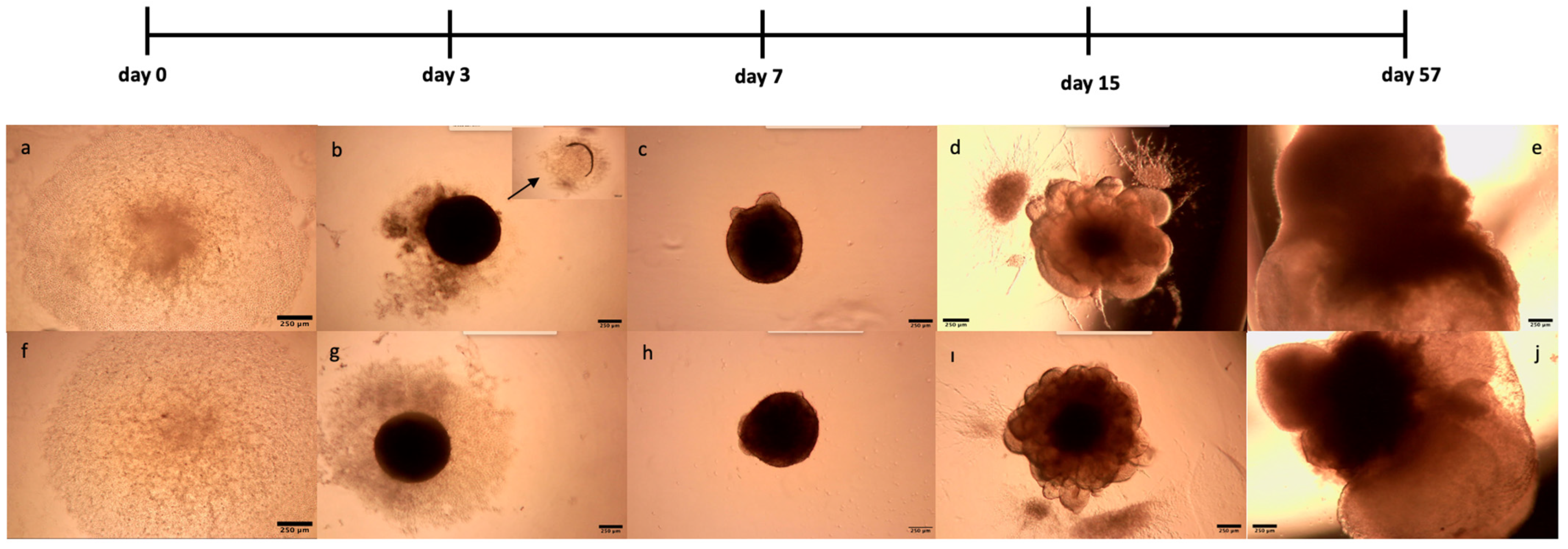

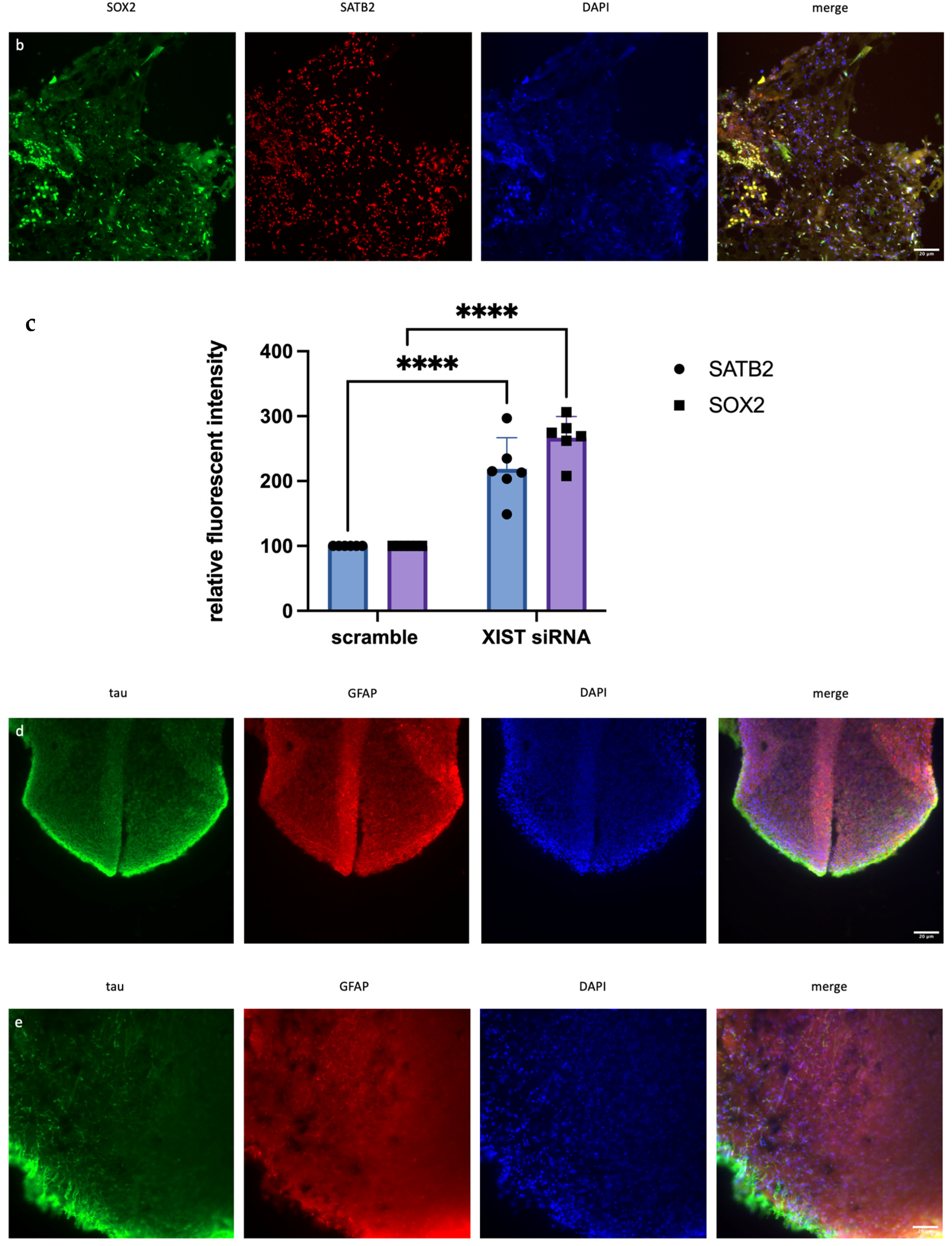

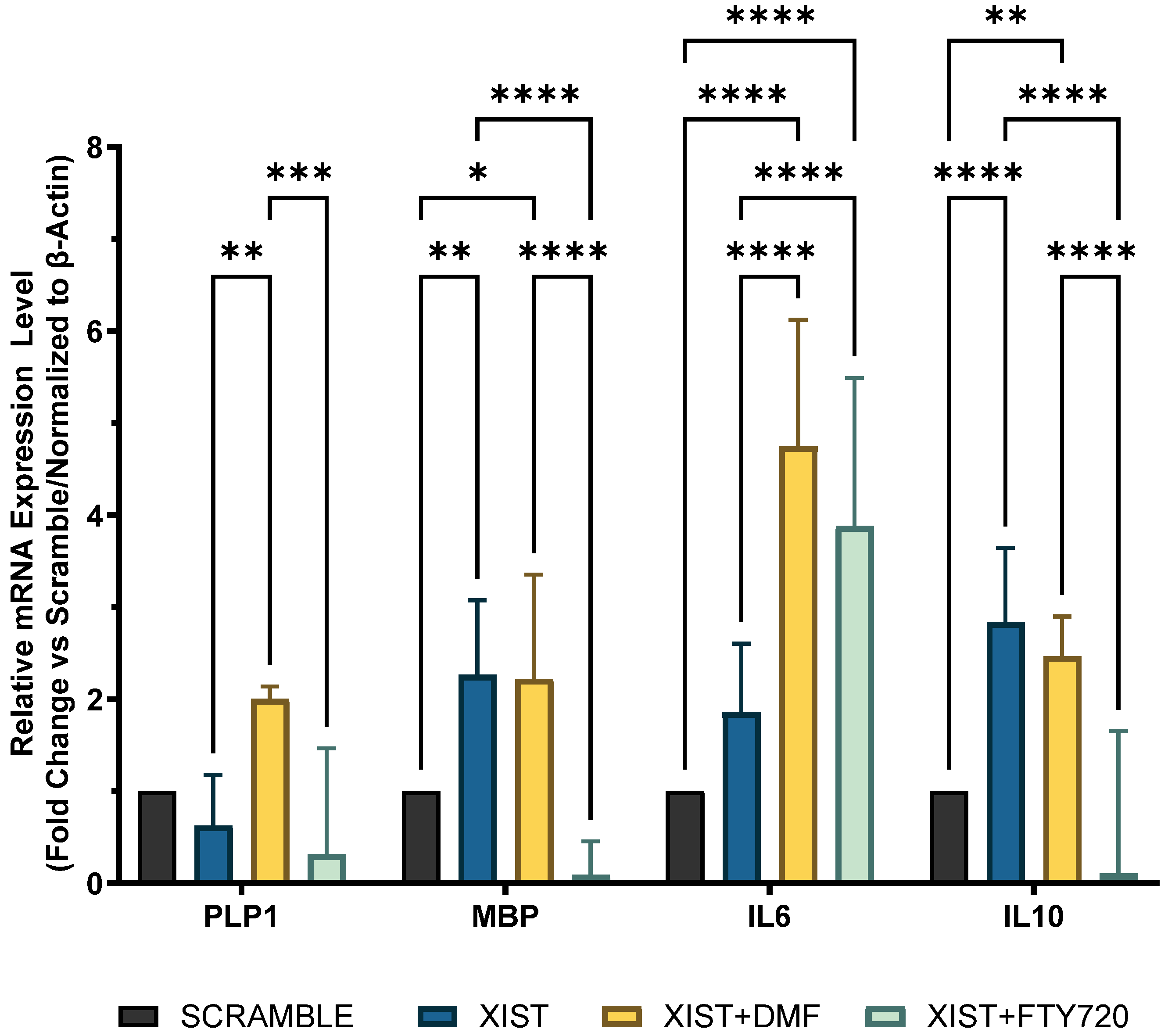
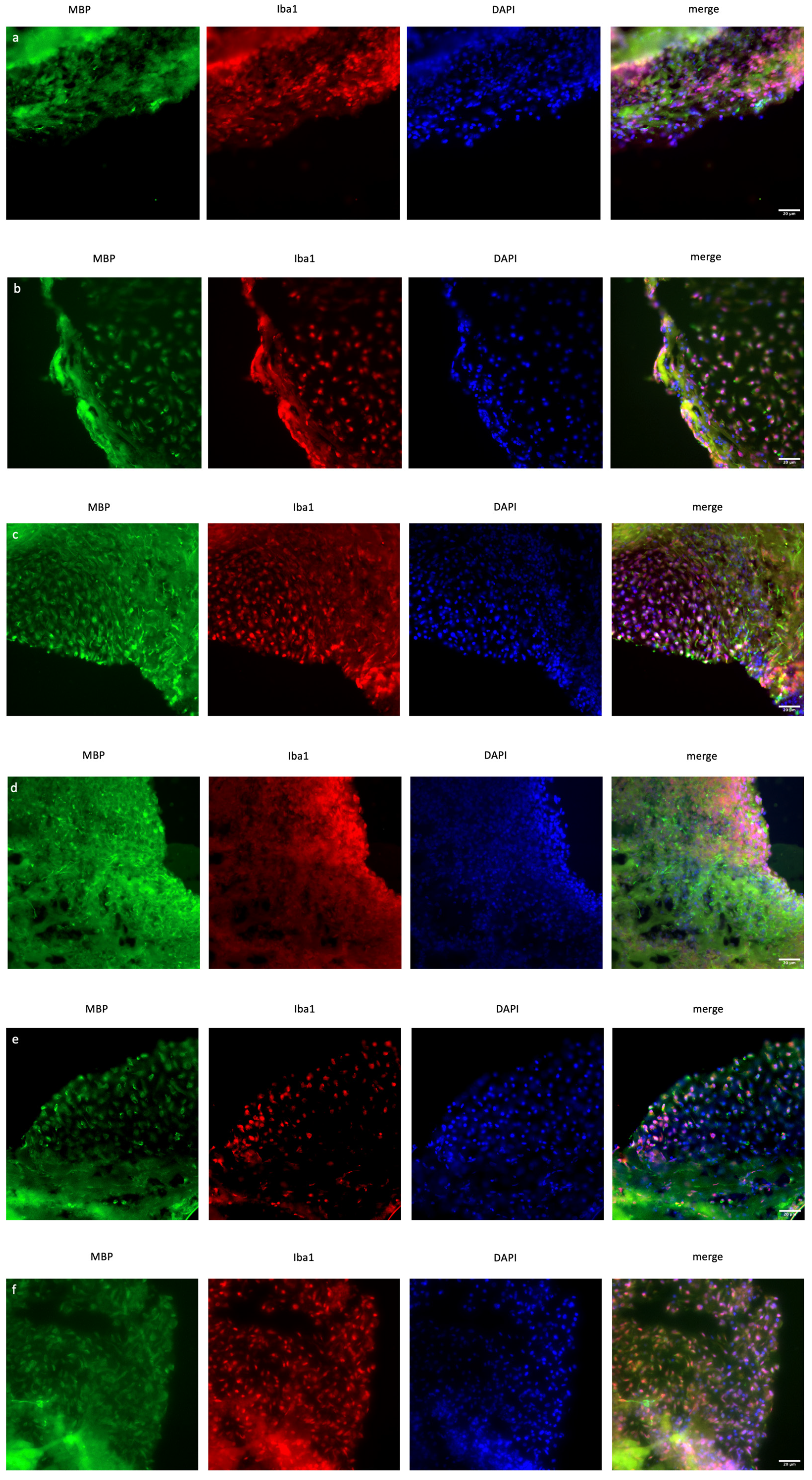

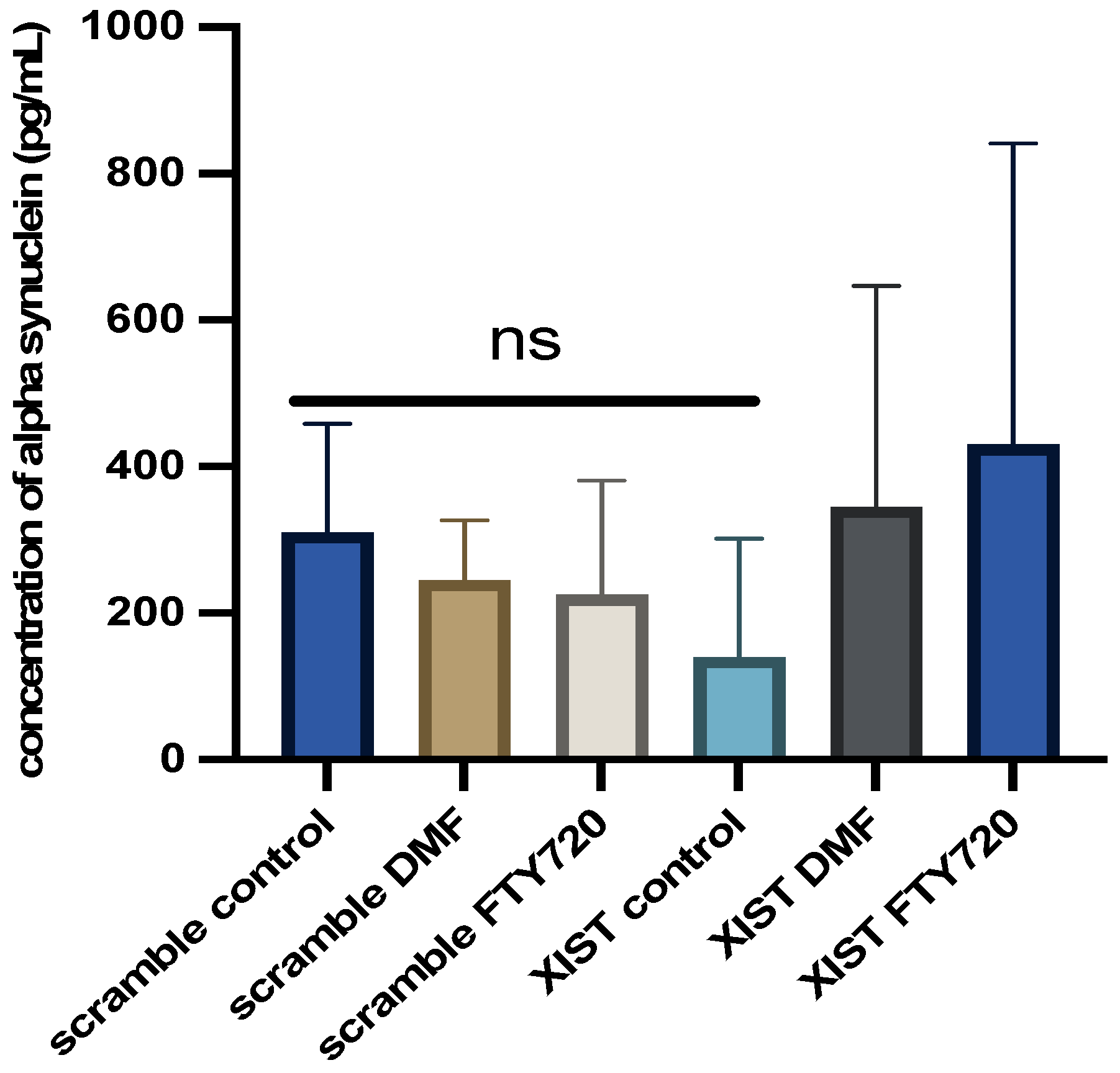
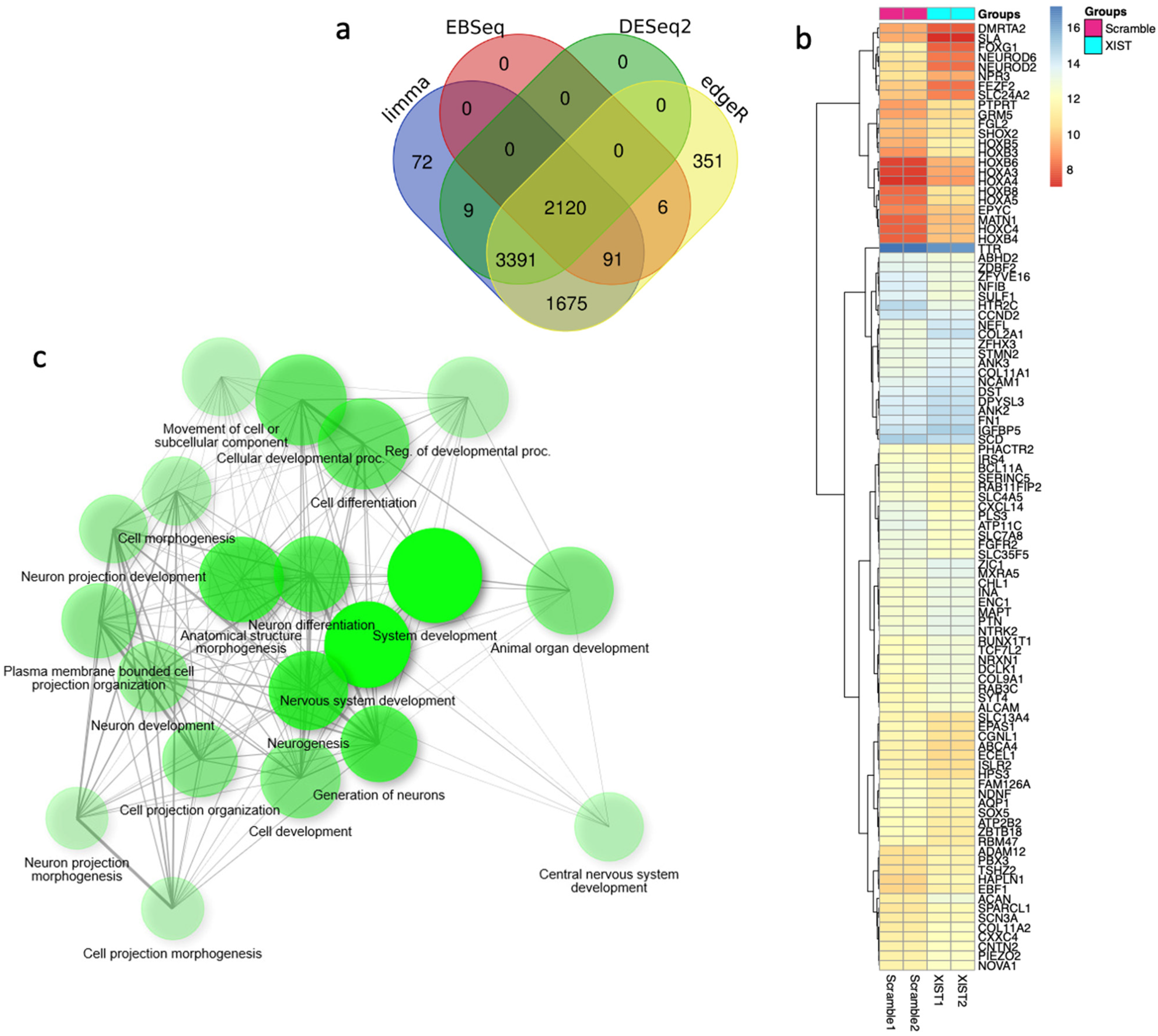

Disclaimer/Publisher’s Note: The statements, opinions and data contained in all publications are solely those of the individual author(s) and contributor(s) and not of MDPI and/or the editor(s). MDPI and/or the editor(s) disclaim responsibility for any injury to people or property resulting from any ideas, methods, instructions or products referred to in the content. |
© 2025 by the authors. Licensee MDPI, Basel, Switzerland. This article is an open access article distributed under the terms and conditions of the Creative Commons Attribution (CC BY) license (https://creativecommons.org/licenses/by/4.0/).
Share and Cite
Aktas Pepe, N.; Acar, B.; Erturk Zararsiz, G.; Ayaz Guner, S.; Sen, A. Role of Long Non-Coding RNA X-Inactive-Specific Transcript (XIST) in Neuroinflammation and Myelination: Insights from Cerebral Organoids and Implications for Multiple Sclerosis. Non-Coding RNA 2025, 11, 31. https://doi.org/10.3390/ncrna11030031
Aktas Pepe N, Acar B, Erturk Zararsiz G, Ayaz Guner S, Sen A. Role of Long Non-Coding RNA X-Inactive-Specific Transcript (XIST) in Neuroinflammation and Myelination: Insights from Cerebral Organoids and Implications for Multiple Sclerosis. Non-Coding RNA. 2025; 11(3):31. https://doi.org/10.3390/ncrna11030031
Chicago/Turabian StyleAktas Pepe, Nihan, Busra Acar, Gozde Erturk Zararsiz, Serife Ayaz Guner, and Alaattin Sen. 2025. "Role of Long Non-Coding RNA X-Inactive-Specific Transcript (XIST) in Neuroinflammation and Myelination: Insights from Cerebral Organoids and Implications for Multiple Sclerosis" Non-Coding RNA 11, no. 3: 31. https://doi.org/10.3390/ncrna11030031
APA StyleAktas Pepe, N., Acar, B., Erturk Zararsiz, G., Ayaz Guner, S., & Sen, A. (2025). Role of Long Non-Coding RNA X-Inactive-Specific Transcript (XIST) in Neuroinflammation and Myelination: Insights from Cerebral Organoids and Implications for Multiple Sclerosis. Non-Coding RNA, 11(3), 31. https://doi.org/10.3390/ncrna11030031





